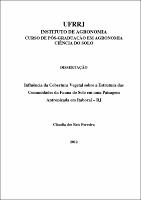Use este identificador para citar ou linkar para este item:
http://rima110.im.ufrrj.br:8080/jspui/handle/20.500.14407/10929| metadata.dc.type: | Dissertação |
| Título: | Influência da cobertura vegetal sobre a estrutura das comunidades da fauna do solo em uma paisagem antropizada em Itaboraí - RJ |
| Título(s) alternativo(s): | Influence of vegetal cover on the community structure of soil fauna in a anthropic landscape of Itaboraí – RJ |
| metadata.dc.creator: | Ferreira, Claudia dos Reis |
| metadata.dc.contributor.advisor1: | Correia, Maria Elizabeth Fernandes |
| metadata.dc.contributor.advisor-co1: | Resende, alexander Silva de |
| metadata.dc.contributor.referee1: | Anjos, Lúcia Helena Cunha dos |
| metadata.dc.contributor.referee2: | Moraes, Luiz Fernando Duarte de |
| metadata.dc.description.resumo: | O uso sem planejamento dos recursos naturais ocasionou a fragmentação da paisagem, isolando a biodiversidade ainda presente na Mata Atlântica nesses fragmentos. Este trabalho teve como objetivo caracterizar a comunidade da fauna de solo, em uma paisagem composta de fragmentos florestais e pastagens abandonadas, e avaliar o grau de influência de diferentes feições da paisagem sobre a diversidade e composição da comunidade da fauna do solo. A comunidade da fauna do solo foi utilizada como ferramenta para avaliar a qualidade dessas áreas. O trabalho foi realizado no município de Itaboraí, região metropolitana do Estado do Rio de Janeiro. Para avaliar a composição da fauna do solo a amostragem foi realizada na estação seca (junho e julho, 2010) em quatro fragmentos florestais e quatro áreas de pastagens abandonadas. As feições de encosta em cada área foram ainda divididas em terços superior, médio e inferior. Durante a coleta da fauna do solo foram usados dois métodos com objetivos distintos. As armadilhas “pitfall” para capturar os organismos que se encontram na interface serrapilheira-solo, denominados fauna epígea, e a metodologia TSBF (Tropical Soil Biology and Fertility) para coletar a macrofauna do solo. Observaram-se diferenças entre as coberturas vegetais e nas posições da encosta para alguns grupos da fauna. As maiores médias de abundância, densidade e riqueza total foram encontradas nos fragmentos florestais. Não foi observado um padrão de variação claro da estrutura dos grupos das comunidades de fauna edáfica nos diferentes terços da encosta. O tipo de cobertura vegetal (fragmento florestal ou pastagem) foi o fator que exerceu maior influência sobre a comunidade da fauna do solo. Os fragmentos florestais, embora muito antropizados e em estágios iniciais de regeneração, apresentaram melhores condições para a colonização dos grupos de organismos da fauna do solo. A análise de componentes principais mostrou que é possível separar as áreas de estudo, principalmente quanto à cobertura vegetal, a variável de maior influência sobre a estrutura da comunidade da fauna edáfica. |
| Resumo: | The unplanned usage of natural resources led to the fragmentation of the landscape, isolating the biodiversity that still exists in the Atlantic Forest in these fragments. This study aimed to characterize the community of soil fauna in a landscape composed of forest fragments and abandoned pastures, and to assess the degree of influence of different landscape features on soil fauna diversity and community composition. The soil fauna community was used as a tool for assessing the quality of these areas. The study was conducted in Itaboraí, metropolitan region of Rio de Janeiro State. To assess the composition of soil fauna the sampling was performed in the dry season (June and July of 2010), in four forest fragments, and four areas of abandoned pastures. The slopes in each site were also divided into upper, middle and bottom sections. Two methods were used for soil fauna sampling, with different goals. Pitfall traps to capture the organisms living in the litter-soil interface, called epigeal fauna; and the methodology TSBF (Tropical Soil Biology and Fertility) used to collect soil macrofauna. Differences were observed between vegetal coverages and the positions of the slope, for some fauna groups. The highest mean abundance, total density and richness were found in the forest fragments. It was not observed a clear pattern of variation for slope sections influence in the strucuture of soil fauna groups. The soil coverage type (forest fragments or pasture) was the factor that most influenced the soil fauna community. The forest fragments, although very altered by human activity, and in the early stages of regeneration, showed better conditions for colonization of soil fauna goups of organisms. The principal component analysis showed that it is possible to separate the study, mainly by its plant coverage, which was the variable that most influenced the structure of the soil fauna community. |
| Palavras-chave: | Fauna edáfica Fragmentos florestais Mata Atlântica Pastagens Soil fauna Forest fragments Atlantic forest Pastures. |
| metadata.dc.subject.cnpq: | Agronomia |
| metadata.dc.language: | por |
| metadata.dc.publisher.country: | Brasil |
| Editor: | Universidade Federal Rural do Rio de Janeiro |
| metadata.dc.publisher.initials: | UFRRJ |
| metadata.dc.publisher.department: | Instituto de Agronomia |
| metadata.dc.publisher.program: | Programa de Pós-Graduação em Agronomia - Ciência do Solo |
| Citação: | FERREIRA, Claudia dos Reis. Influência da cobertura vegetal sobre a estrutura das comunidades da fauna do solo em uma paisagem antropizada em Itaboraí - RJ. 2012. 71 f. Dissertação (Mestrado em Agronomia - Ciência do Solo) - Instituto de Agronomia, Universidade Federal Rural do Rio de Janeiro, Seropédica, 2012. |
| metadata.dc.rights: | Acesso Aberto |
| URI: | https://rima.ufrrj.br/jspui/handle/20.500.14407/10929 |
| Data do documento: | 19-Mar-2012 |
| Aparece nas coleções: | Mestrado em Agronomia - Ciência do Solo |
Se for cadastrado no RIMA, poderá receber informações por email.
Se ainda não tem uma conta, cadastre-se aqui!
Arquivos associados a este item:
| Arquivo | Descrição | Tamanho | Formato | |
|---|---|---|---|---|
| 2012 - Cláudia dos Reis Ferreira.pdf | 2012 - Cláudia dos Reis Ferreira | 3.54 MB | Adobe PDF |  Abrir |
Os itens no repositório estão protegidos por copyright, com todos os direitos reservados, salvo quando é indicado o contrário.

